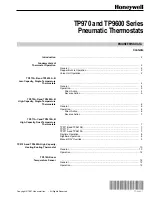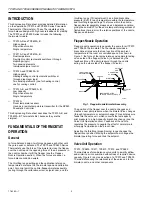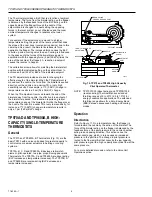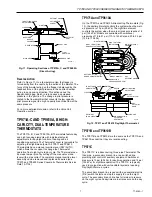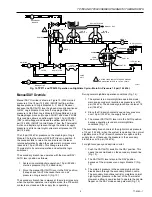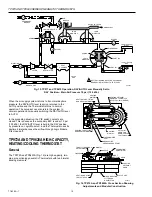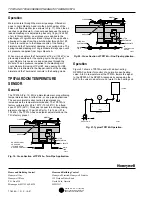
6
TP970 AND TP9600 SERIES PNEUMATIC THERMOSTATS
77-9382—1
The Thermostat provides a BLP that is a function of ambient
temperature. The force from the bimetal acting on the flapper
is balanced by the feedback force of the BLP acting on the
opposite side of the flapper through the nozzle. If the
setpoint knob is changed to a new setting, the opposing
forces in the lever system go out of balance and the room
ambient temperature changes to rebalance the lower
system.
For example, if the setpoint cam is moved to a higher
temperature setting, the point of the lever system that rides
the slope of the cam rises (reverse-acting device) due to this
cam slope. As a result, the bimetal increases its force
applied to the flapper. The increased force causes the BLP
to build up and a cooling valve to open. Cooling is introduced
to the space until the forces of the bimetal are again in
equilibrium with the opposing force (8 psi [55 kPa] times the
area of the nozzle at the flapper). A reduction in setpoint
causes the reverse to happen.
The calibration screw allows for matching the bimetal start
position with the indicated setting on the setpoint cam to
achieve an 8 psi (55 kPa) BLP at the indicated setpoint.
The TR adjustment provides a means for changing the
effective length of the bimetal. When the TR adjustment is
moved over the nozzle, the force from the bimetal is exerted
directly over the nozzle and a narrow TR, or very high
sensitivity, results. For example, a 1
°
F (0.56
°
C) change in
temperature results in a 5 psi (34 kPa) BLP change.
When the TR adjustment is moved toward the end of the
bimetal away from the nozzle, the effective force output of
the bimetal is reduced. This reduction requires a greater
temperature change at the bimetal to throttle the flapper over
the nozzle. The result is a wider TR or very low sensitivity; for
instance, a 1
°
F (0.56
°
C) change in temperature results in
only a 1 psi (7 kPa) BLP change.
TP970A-D AND TP9600A, B HIGH-
CAPACITY, SINGLE-TEMPERATURE
THERMOSTATS
General
The TP970 and TP9600A, B Thermostats (Fig. 10) are the
basic TP973 with a valve unit added for greater capacity to
control valve or damper actuators in heating or cooling
systems.
TP970A, B, C, D and TP9600A, B devices are bimetal-
element, pilot-operated, two-pipe, proportioning pneumatic
Thermostats. The TP970A, C and TP9600A are direct acting
(BLP increases as temperature increases). The TP970B, D
and TP9600B are reverse-acting (BLP decreases as
temperature increases).
Fig. 10. TP970 and TP9600 High Capacity
Pilot Operated Thermostat.
NOTE:
TP970C1000 (direct acting) and TP970D1008
(reverse acting) Thermostats have extended
throttling ranges of 5 to 20
°
F (2.5 to 10
°
C) for
energy conservation applications. The extended
throttling range allows for a Zero Energy Band
(ZEB) between sequenced heating and cooling
modes.
Operation
Direct Action
Refer to Figure 11. On a temperature rise, the flapper is
forced toward the nozzle by the action of the bimetal. The
force of the bimetal acting on the flapper is balanced by the
feedback force of the pilot pressure in the nozzle chamber
acting in an opposing direction. This action varies the
flapper-nozzle gap, which in turn causes an increased
pressure in the pilot line. The change in pilot pressure is
routed to the flow amplifier that converts the low capacity
pilot pressure signal to a high capacity branchline flow at the
same pressure.
For a more detailed discussion, refer to the Valve Unit
Operation section.
FLAPPER
THROTTLING RANGE
ADJUSTMENT
BRANCH LINE
PRESSURE GAGE PORT
BIMETAL
NOZZLE
CALIBRATION
SCREW
SETPOINT
CAM
SETPOINT
KNOB
SETPOINT KNOB
VALVE UNIT
C6055

